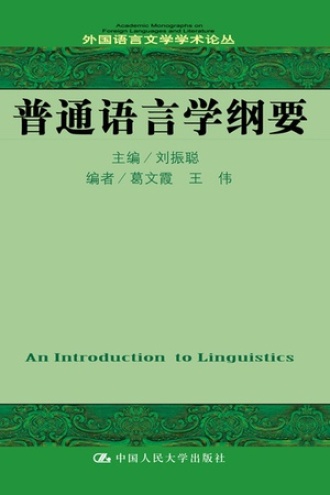
普通语言学纲要
¥19.30
作品简介
普通语言学及其研究领域;语言学史,包括传统语言学、历史比较语言学和现代语言学;语言学流派及其理论方法,包括描写语言学、功能语言学、结构主义语言学、转换生成语法等;语言结构系统,包括音系学、形态学、句法学、语义学和语用学;语言学与相关学科的关系,包括心理语言学、人类语言学、社会语言学和应用语言学等。
刘振聪:应用语言学博士,现为北京第二外国语学院应用英语学院副教授、硕士生导师。学术兼职:北京第二外国语学院学术委员会应用英语学院分会委员,北京联合大学客座教授。主要研究领域包括普通语言学、认知语言学、跨文化交际、英语教学理论与实践、翻译理论与实践等,主持或参与教育部师范司“英语教学研究与论文写作”项目等多项省部级、校级教学科研项目和其它横向联系项目,在《外语教学与研究》、《英语教学》、《山东外语教学》等刊物发表论文20余篇,主编、参编教材、辞典多部。
作品目录
前言
Chapter 1 Language and Linguistics
Introduction:
1.What Is Linguistics?
2.The Branches of Linguistic
3.Important Distinctions in Linguistics
4.What Is Language?
5.Design Features of Language
6.Origin of Language
7.Functions of Language
CASE STUDY The Tower of Babel
Exercises
Suggestions for Further Reading
Chapter 2 Phonetics and Phonology
Introduction:
1.What Is Phonetics?
2.Organs of Speech
3.Broad and Narrow Transcriptions
4.Classification of English Speech Sound
5.Classification of English Vowel
6.What Is Phonology?
7.Phone,Phoneme,and Allophone
8.Phonemic Contrast,Complementary Distribution,and Minimal Pair
9.Some Rules in Phonology
10.Suprasegmental Features
CASE STUDY What Can Phonetics and Phonology Do Solve Crime?!
Exercises
Suggestions for Further Reading
Chapter 3 Morphology
Introduction:
1.What Is Morphology?
2.Word Class,Open Class and Closed Class
3.Morpheme(词素),Allomorph(词素变体),Free and Bound Morpheme,Root,Affix,Stem,Prefix and Suff
4.Derivational and Inflectional Morphem
5.Morphological Rules and Word Formation
6.Compounds(复合词)
7.Derivation(派生词)
8.Conversion(转换词)
9.Backformation(逆构词法)
10.Clipping(截断法)
11.Blending(混合词)
12.Acronym(首字母缩略词)
13.Initialism(首字母组合)
14.Invention
15.Borrowing
CASE STUDY Enlarge English Vocabulary through Mobile Apps
Exercises
Suggestions for Further Reading
Chapter 4 Semantics
Introduction:
1.What Is Semantics?
2.Some Views on Meaning
3.Sense and Reference
4.Seven Types of Meaning
5.Semantic Fields
6.Componential Analysis
7.Major Sense Relations Between Words
8.Sentence and Proposition
9.Semantic Roles
10.Predication Analysis
11.Semantic Relationships Between Sentences
CASE STUDY Meaning of Colors
Exercises
Suggestions for Further Reading
Chapter 5 Syntax
Introduction:
1.What Is Syntax?
2.Word-level Categories
3.The Prescriptive Approac
4.The Descriptive Approac
5.Constituent Structure Grammar
6.Systemic Functional Grammar
7.Phrase Categories and Phrase Structures
8.Phrase Structure Rule
9.The S Rule:S→NP V
10.Transformations
CASE STUDY Shuōwén Jiěz?
Exercises
Suggestions for Further Reading
Chapter 6 Pragmatics
Introduction:
1.What Is Pragmatics?
2.Sentence Meaning and Utterance Meaning
3.Micropragmatics and Macropragmatics
4.Reference
5.Deixis
6.Anaphora
7.Presupposition
8.Speech Act Theor
9.Classification of Illocutionary Act
10.Indirect Speech Acts
11.The Cooperative Principle and Its Maxim
12.Conversational Implicatures
13.The Politeness Principl
14.Relevance Theor
CASE STUDY The Violation of the Maxim of Quality
Exercises
Suggestions for Further Reading
Chapter 7 Discourse Analysis
Introduction:
1.What Is Discourse and Discourse Analysis?
2.Information Structure
3.Cohesion
4.Coherence
5.Discourse Markers
6.Conversational Analysis
7.Critical Discourse Analysis
CASE STUDY Joke:How Man Differs from Woman
Exercises
Suggestions for Further Reading
Chapter 8 Schools of Linguistics
Introduction:
1.Traditional Grammars
2.Saussure and Modern Linguistics
3.The Prague Schoo
4.The London Schoo
5.American Structuralism
6.Chomsky’s Transformational-Generative Grammar
7.Case Grammar
8.Generative Semantics
CASE STUDY International Mother Language Day
Exercises
Suggestions for Further Reading
Chapter 9 Teaching Methodology and Testing
Introduction:
1.The Grammar-Translation Method
2.The Direct Metho
3.The Audio-Lingual Metho
4.Situational Language Teaching
5.Functional Language Teaching
6.Communicative Language Teaching
7.Classification of Tes
8.The Main Types of Language Test
9.Principles of Language Testing
CASE STUDY Coursera and Netease’s Open Class
Exercises
Suggestions for Further Reading
Chapter 10 First and Second Language Acquisition
Introduction:
1.Theories of Child Language Acquisitio
2.Factors in Child Language Development
3.Stages of Acquiring the First Language
4.Atypical Development of Child Language
5.The Relationship Between First and Second Language Acquisition
6.Contrastive Analysis
7.Error Analysis(EA)
8.Interlanguage
9.SLA Models and Input Hypothesis
10.Individual Difference
CASE STUDY Poverty of the Stimulus
Exercises
Suggestions for Further Reading
Chapter 11 Cognitive Linguistics
Introduction:
1.Categorization and Categories
2.The Classical Theory of Categorizati
3.The Prototype Theory of Categorizati
4.Levels of Categorization
5.Conceptual Metaphor
6.Conceptual Metonymy
7.Image Schemas
8.Iconicity
9.Grammaticalization
CASE STUDY Metaphors We Live By
Exercises
Suggestions for Further Reading
Chapter 12 Language and Culture
Introduction:
1.The Definition of Cultu
2.The Relationship between Language and Cultur
3.The Sapir-Whorf Hypothesi
4.Cultural Difference
5.The Significance of Cultural Teaching and Learni
6.Cultural Overlap and Diffusio
7.Cross-cultural Communication
CASE STUDY Chinese Dragon vs.Western Dragon
Exercises
Suggestions for Further Reading
Chapter 13 Sociolinguistics
Introduction:
1.The Definition of Sociolinguistics and Its Sco
2.Language Varieties
3.Language Planning
4.Diglossia
5.Bilingualism and Multilingualism
6.Code-switching
7.Linguistic Taboos and Euphemisms
8.Language and Gender
CASE STUDY A New York City Study by William Labov
Exercises
Suggestions for Further Reading
Chapter 14 Psycholinguistics
Introduction:
1.The Definition of Psycholinguisti
2.Research Methods in Psycholinguistics
3.Language Acquisition
4.Language Production
5.Language Comprehension
6.Language and Though
CASE STUDY Rat&Food Experiment by B.F.Skinner
Exercises
Suggestions for Further Reading
Chapter 15 Neurolinguistics
Introduction:
1.The Definition of Neurolinguisti
2.The Structure and Function of the Human Brai
3.Methods in Neurolinguistics and Evidences for Lateralization
4.Aphasia
CASE STUDY Neurolinguistics as an Interdisciplinary Field
Exercises
Suggestions for Further Reading
Chapter 16 Corpus Linguistics
Introduction:
1.Corpus
2.Famous Figures
3.Development of Corpus Linguistics
4.Factors to Be Considered When Designing a Corpus
5.Four Aspects Considered for A Diachronic Multipurpose Corpus
6.Text Encoding and Annotation
7.Types of Corpora
8.Taxonomies of Corpora
9.Representative Corpora
10.Features of Corpus Linguistics
11.Applications of Corpora
12.Software Programs for Corpor
13.Strengths of Corpus Linguistics
14.Weaknesses of Corpus Linguistics
15.Future Trends
CASE STUDY Global Language Monitor
Exercises
Suggestions for Further Reading
Chapter 17 Stylistics
Introduction:
1.The Definition of Stylisti
2.General Features of the Literary Language
3.The Language in Poetr
4.The Language in Fictio
5.The Language in Dram
6.The Cognitive Approach to Literatur
7.Style of English for Science and Technology
8.Journalistic English Style
9.Style of English for Advertisement
CASE STUDY Turn-taking Style in Translation
Exercises
Suggestions for Further Reading
References
载入中